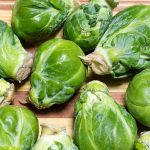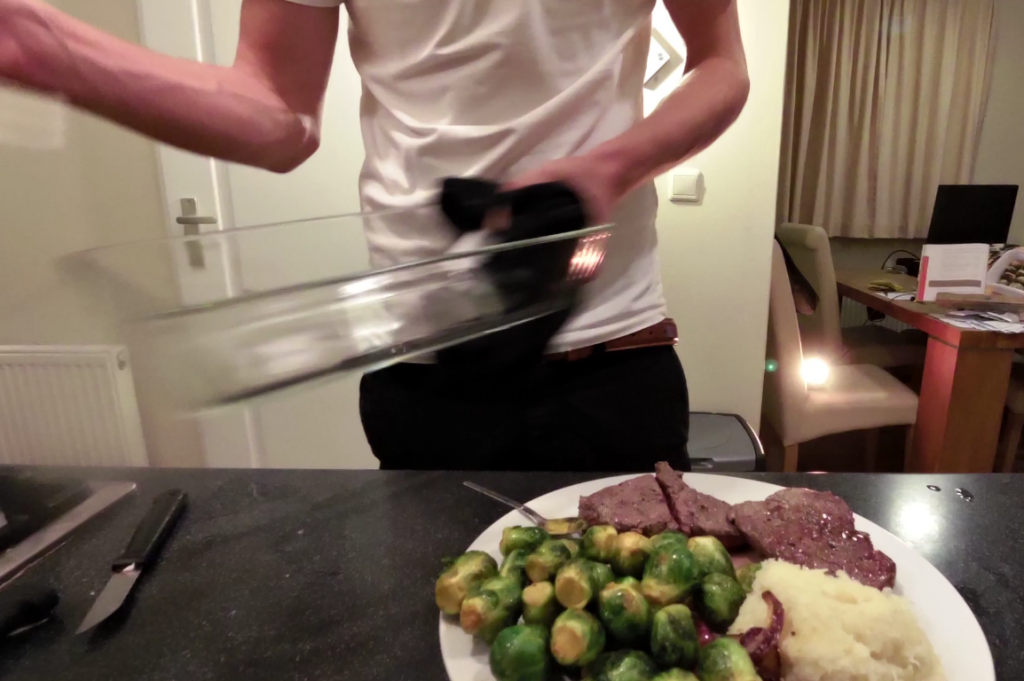Autumn meal series
In this ‘Autumn meal’ series I’m going to make a couple of dishes using local and seasonal ingredients. I’m no chef, in fact, far from it. Many of the ingredients I’ve never known about it’s existence. But that’s the challenge! Learn to cook, experience new flavors and, well, survive!
Ingredients (2 pers.)
- 2 steaks of 150g (roe, deer or beef)
- 500g sprouts
- 400g parsnip
- 1 galic bulb
- 2 red unions
- olive oil
- curcuma spices
- salt/pepper
Preparation time: +/- 60min
It’s autumn in North Holland, which means summer has come to an end, the weather is getting colder and the days shorter. It also means a lot of seasonal fruits and vegetables are ready for consumption, so in this meal, we’ll have a look at sprouts and parsnip
We start of with a dish for 2 persons that includes a nice steak, sprouts from the oven, fried unions and parsnip puree. Rather safe, everybody likes a good steak and the fried unions can cover up the potential horrible taste of the sprouts and parsnip puree?! Before we start in the kitchen, let’s first have a look at the seasonal ingredients. What is it? Where do they come from? What are they like? All questions that came to my mind when I first saw the list of ingredients.
Sprouts

Sprouts are a cultivar group of the same species as cabbage, in the same family as broccoli and kale. Containing excellent levens of vitamin C, K and moderate amounts of B vitamins, such as folic acid and vitamin B6, spouts are a healthy choice. Essential minerals and dietary fiber exists in lesser amounts.
Sprouts grow on stalks, are sown between February and mid-April and are harvested from August up to March. Sprouts can withstand -15 deg Celsius temperature and in fact, some say they taste better after a good frost!
Source: Wikipedia
Parsnip
Usually cooked, parsnip can also be eaten raw. It’s high in vitamins and minerals, especially potassium. Also containing antioxidants and dietary fiber it’s a healthy vegetable to eat.
Parsnip is a biennial plant usually grown as annual. If unharvested, in the second year it will produce it’s flowering stem with small yellow flowers. It’s not all nice though, handling the stems and foliage can cause a skin rash…
Seeds are usually planted early spring and the harvest begins late fall after the first frost. The frost will cause some of the starches in the root to be converted into sugars, giving them a sweeter taste.
Source: Wikipedia
Preperation
So you are ready to give it a try? Head out to the grocery store or, even better, get some of the products form your local farmer! Also, this recipe is put together in it’s most logic and fastest order, so just follow the step plan and all will be ready at the same time.
Before we begin the actual cooking, if you have it stored in the fridge, take out the steaks and let it get to room temperature. This usually takes about 30 min. If you take them out now, you can start preparing the meal as it will take about 30 min before we even start with the steak. How clever!
step 1
Ingredients
- 500g sprouts
- 2 tbsp olive oil
- 1 tsp curcuma
- pepper
Duration: Â +/- 55 min
Sprouts from the oven
First things first, heat the oven to 200 °C. Clean the sprouts with water and cut the bigger sprouts into half’s. Take out a bowl and mix the sprouts with the olive oil, the curcuma spices and pepper.
Place baking paper in a baking dish and spread the sprouts evenly. Put a sheet of baking paper on top of the baking dish and bake the sprouts in the oven for about 45 minutes.
step 2
Ingredients
- 400g parsnip
- 1 galic bulb
- 1 tsp olive oil
Duration: Â +/- 25 min
Parsnip puree
Peel the parsnips and cut into pieces. You can start this straight after you put the sprouts in the oven. After the sprouts have been in the oven for about 15 to 20 minutes, boil the parsnip and the garlic bulb tender in about 15 minutes using a little bit of water. Once boiled, puree the vegetables in a blender and add a dash of olive oil.
While you can boil the parsnip straight after putting the sprouts in the oven, I recommend to wait a little so it’s all ready at the same time, making sure you eat warm parsnip puree.
step 3
Ingredients
- 1-2 red unions
- 2-4 tbsp olive oil
- salt
Fried unions
This is probably the most easy part of this recipe. All you have to do is peel the unions and cut them into rings. Add the oil in the pan and fry the unions with a pinch of salt. Bake the unions on a low fire for about 15 minutes while stirring frequently.
While at it, continue with step 4 to have all parts of the dish ready in the same time.
step 4
Ingredients
- 2 steaks of 150 g
- 3-4 tbsp olive oil
- pepper and salt
Steak (roe, deer or beef)
There are many ways to prepare a steak, but in order to get a nice, tender and full of flavor steak, there a a few fundamentals. First and foremost, do not use a anti-sticking pan. Before doing anything else with the steaks, dry them using a piece of kitchen paper or clean towel. Also, put your stove on 8 out of 10 when adding the oil. In this way the oil can evenly melt.
Next, put a good layer of salt and pepper on one side of each steak. Once the oil is melted, put your stove on it’s max heat and lay down the steaks with the spiced sides down. Now you can add the salt and pepper on side of the steaks facing you.
Leave the steaks in the pan but keep moving them. Usually after a minute or 2 you can turn the steaks over. Regular check if the steaks are still ‘soft’ by pressing the meat with your thumb. As a reference, make a circle with your index finger and thumb and press the ball on the palm side of your thumb. Steaks with the same soft texture will be rare. If you make a circle with your little finger and thumb and press the ball of thumb, you will find that steaks with the same firm feeling will be well done.
Preparation:Â
Taste:Â
Overall:Â
The verdict
This dish is rather simple to prepare but the sprouts take some time in the oven. Let’s face it, the steak and fried unions are liked by almost everybody. While in my case I had the steaks for a bit to long in the pan, making them a ‘well done’ (I prefer rare or medium done), they still tasted good.
The scary part, the sprouts. They tasted like, well… I guess you need to like the taste of spouts. There is a taste, there sure is, but I didn’t like it much. I was able to eat a few sprouts before it really became too much… No more sprouts for me.
The parsnip puree then. This was surprisingly fine. It’s like potato puree but sweeter. I would describe it as if it had a bit of a lemon/citrus taste over it. I could definitely eat it again, though I’m not blown away by the ‘amazing’ taste.
All in all, this meal won’t let anyone starving, but especially the sprouts are for those few sprout lovers. Preparing it was not too hard which is the reason I’ll give this dish a 3 out of 5.
